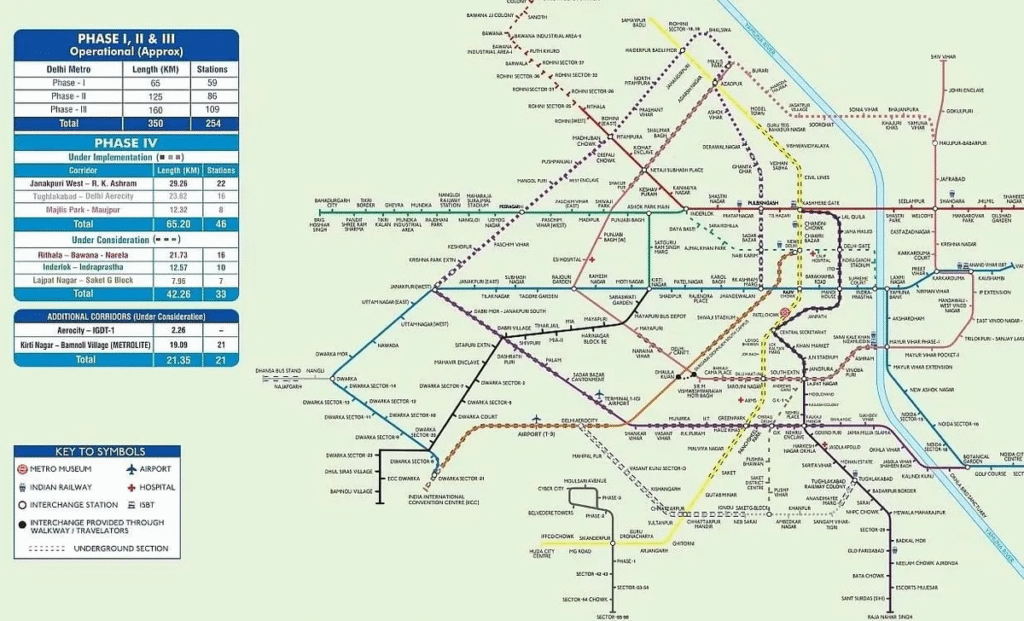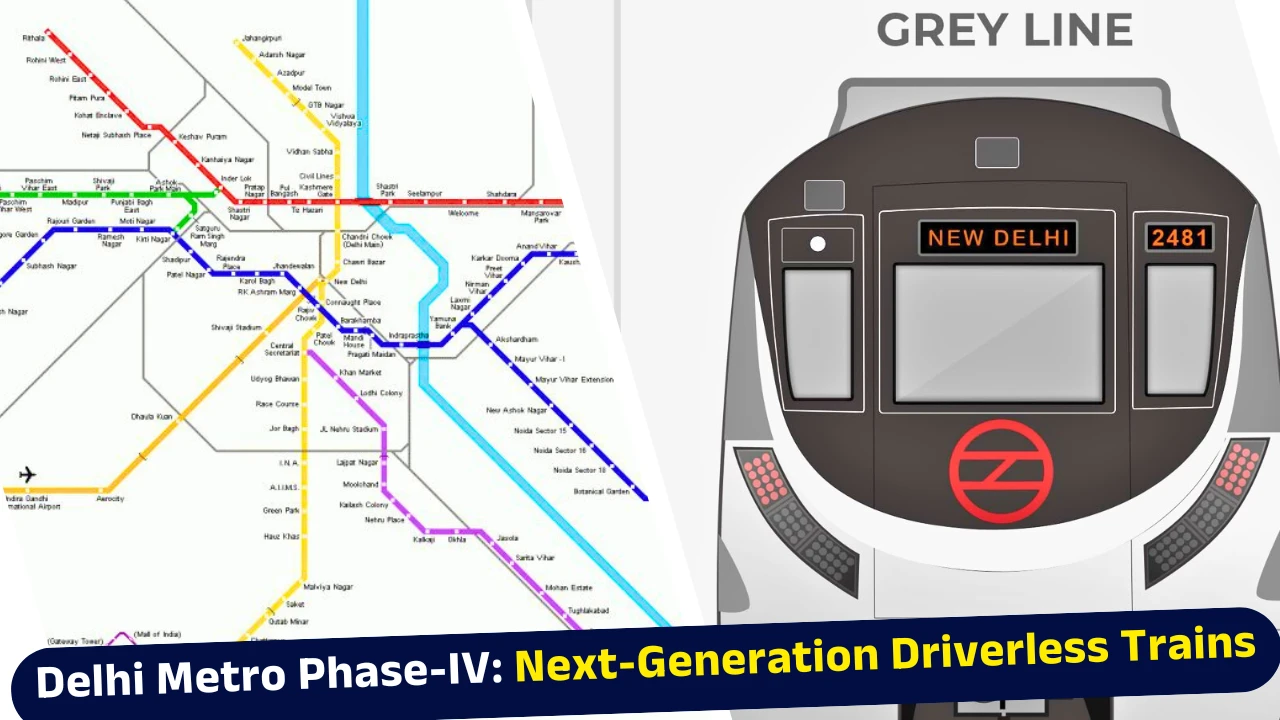The Delhi Metro Rail Corporation (DMRC) is preparing to usher in a new era of modern and intelligent public transport as it gears up to introduce driverless trains on its upcoming Phase-IV corridors. The initiative aims to enhance operational efficiency, improve passenger safety, and reduce human intervention across one of India’s largest metro networks.
India’s first driverless metro operations began on the Magenta Line (Janakpuri West–Botanical Garden) in December 2020, inaugurated by Prime Minister Narendra Modi. Building on this technological milestone, DMRC now plans to expand Unattended Train Operation (UTO) systems to new routes, transforming how millions of commuters travel across the National Capital Region (NCR).
Key Takeaways: Delhi Metro Phase-IV Driverless Train Expansion
- DMRC to deploy driverless trains across all upcoming Phase-IV corridors.
- 69 driverless trains currently operational : 43 on the Pink Line and 26 on the Magenta Line.
- India’s first driverless train flagged off on December 28, 2020, by PM Narendra Modi.
- Driverless operations to extend to Pink & Magenta Line extensions and the Aerocity–Tughlakabad (Golden Line).
- After completion, Delhi Metro will become the world’s second-largest driverless metro network, spanning 160 km of UTO-equipped corridors.
- Phase-IV project includes six corridors, three of which are under priority construction.
DMRC’s Vision: Smarter, Safer, and Faster Metro Services
According to DMRC, introducing driverless technology has already improved train availability, reduced operational delays, and enhanced passenger safety. A senior DMRC official confirmed that all new corridors in Phase-IV will feature Unattended Train Operation (UTO) technology, marking a significant expansion of automation within the network.

The initiative aims to minimise human errors, streamline train scheduling, and ensure a more reliable commuting experience. By reducing manual checks before induction, DMRC has also lightened the workload on train operators while maintaining strict safety standards.
Official Info from DMRC: https://delhimetrorail.com/pages/en/phase-iv
The Success Story of Driverless Operations in Delhi Metro
The journey of driverless operations began when Prime Minister Narendra Modi inaugurated the country’s first driverless train on the Magenta Line on December 28, 2020. The move positioned Delhi Metro as a pioneer in modern rapid transit technology in India.
Currently, 69 driverless trains are operational under the UTO system : 43 on the Pink Line (Line 7) and 26 on the Magenta Line (Line 8). These trains have demonstrated higher punctuality, smoother acceleration, and enhanced energy efficiency compared to conventional ones.
Phase-IV: The Blueprint of Delhi’s Metro Expansion
The Phase-IV expansion of the Delhi Metro comprises six corridors, with three priority corridors currently under construction:
1. Majlis Park to Maujpur (Pink Line extension)
2. Janakpuri West to RK Ashram Marg (Magenta Line extension)
3. Delhi Aerocity to Tughlakabad (Golden Line)
The remaining three corridors include:
- Inderlok to Indraprastha (Green Line)
- Lajpat Nagar to Saket G Block (Golden Line)
- Rithala to Kundli (Red Line)
Upon completion, these corridors will strengthen interconnectivity across Delhi and the NCR, decongest existing lines, and significantly improve last-mile connectivity.
Technological Advancement: How UTO Transforms Commuting
The Unattended Train Operation (UTO) system enables driverless control, automatic train movement, and real-time monitoring, ensuring both efficiency and safety. This system minimizes delays by optimizing operational intervals and ensures consistent speed and braking patterns without human error.

By leveraging UTO, DMRC has eliminated manual safety inspections before daily operations. The trains are equipped with automated diagnostics, reducing downtime and enhancing the availability of rolling stock for passengers.
DMRC’s Global Milestone: Becoming the Second-Largest Driverless Network
Once the Phase-IV corridors are completed and the driverless extensions on the Pink, Magenta, and Golden Lines are fully functional, Delhi Metro will become the world’s second-largest driverless metro network, covering approximately 160 kilometres of UTO-enabled routes.
This milestone will place Delhi Metro in the league of globally advanced systems like those in Singapore, Dubai, and Paris, solidifying India’s position as a leader in mass rapid transit innovation.
Impact on Commuters and the Capital
The expansion under Phase-IV is not merely an infrastructural upgrade ; it is a revolution in urban mobility. The deployment of driverless trains will mean:
- Shorter waiting times and faster connectivity between key areas.
- Improved punctuality due to automated scheduling and monitoring.
- Higher safety standards with continuous real-time control.
- Reduced operational costs and improved energy efficiency.
Moreover, the network’s expansion will strengthen the integration of NCR towns, boost economic activities, and make public transport a more attractive and reliable option for millions of commuters.
Delhi’s Metro Future: Towards Smarter Public Transport
With Phase-IV, the Delhi Metro Rail Corporation is taking a major step toward building a smart, sustainable, and technology-driven transport ecosystem. The introduction of driverless trains is a testament to DMRC’s commitment to innovation and its vision to deliver safe, efficient, and environment-friendly urban mobility.
As the network continues to expand, Delhi is steadily transforming into a global model for intelligent metro systems, proving that technology and safety can move hand in hand toward a smarter, greener future.
Transforming Urban Travel: Delhi Metro’s Leap into Automation
The rollout of driverless trains in Phase-IV is not just a technological upgrade : it’s a symbol of India’s progress in intelligent urban mobility. With world-class automation, greater efficiency, and unmatched passenger safety, the Delhi Metro is redefining how a city moves.
As construction progresses across six new corridors, commuters can look forward to a faster, safer, and smarter ride ; a true reflection of India’s journey toward next-generation public transport.
Spiritual Insight: The Divine Wisdom of Saint Rampal Ji Maharaj Ji
Beyond technological advancements, true guidance and inner peace come from spiritual knowledge. Tatvdarshi Sant Rampal Ji Maharaj reveals the path to eternal bliss and liberation, emphasizing that material progress alone cannot fulfill the soul. His teachings inspire millions to live a life of righteousness, devotion, and higher consciousness.
FAQs on Delhi Metro Phase-IV Driverless Trains
1. When will Delhi Metro Phase-IV introduce driverless trains?
DMRC plans to introduce driverless trains with Phase-IV completion, expanding automation across six new corridors including Pink, Magenta, and Golden Line routes.
2. Which Delhi Metro lines currently operate driverless trains?
Driverless operations are active on the Magenta Line and Pink Line, with 69 trains : 43 on Pink and 26 on Magenta under the Unattended Train Operation (UTO) system.
3. What is the main goal of DMRC’s driverless train expansion?
The goal is to enhance safety, improve efficiency, and reduce human intervention by expanding the Unattended Train Operation (UTO) system across new Phase-IV corridors.
4. How will Phase-IV impact Delhi’s metro connectivity?
Phase-IV’s six corridors will strengthen NCR connectivity, reduce travel time, and extend Delhi Metro’s driverless network to 160 kilometres ; making it the world’s second largest.
5. When did Delhi Metro launch its first driverless train?
India’s first driverless train was launched on Delhi Metro’s Magenta Line on December 28, 2020, inaugurated by Prime Minister Narendra Modi.

















